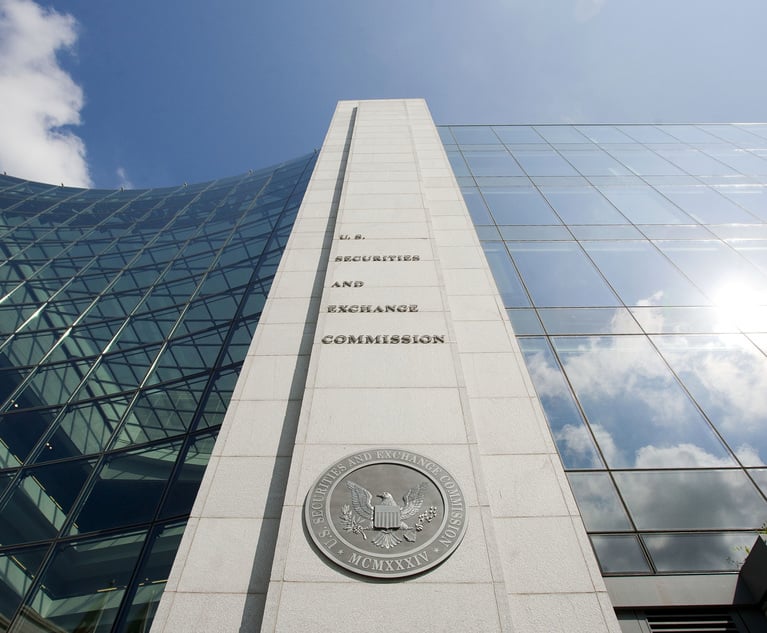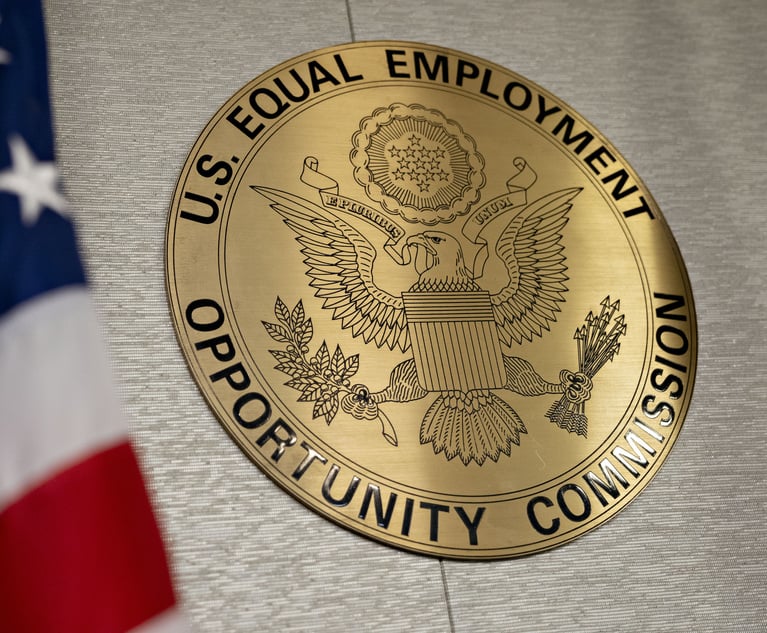Ding-dong, wicked securities class action suits are dead?
Its a nice thought, but dont drop the companys D&O insurance just yet. While the Court has an opportunity in Halliburton to severely curtail securities class action suits, it probably wont.
January 26, 2014 at 07:00 PM
6 minute read
And the bells rang out: “Wicked securities class action suits are dead!” At least this is what some hopeful prognosticators are saying now that the U.S. Supreme Court has decided to hear Halliburton v. Erica P. John Fund, a challenge to the way classes are certified in Section 10(b) securities cases. It's a nice thought, but don't drop the company's D&O insurance just yet. While the Court has an opportunity in Halliburton to severely curtail securities class action suits, it probably won't.
First, a quick reminder: securities class action suits are filed by a company's shareholders against the company as well as its directors and officers. When they sue under section 10(b) of the Securities and Exchange Act, shareholders are suing for damages that resulted from material misrepresentations or omissions made by the company. Such a securities suit could be brought by an individual shareholder. The mega-dollar settlements reported in the press, however, are usually the result of a large group of shareholders suing as a class.
Should shareholders be allowed to sue as a class? Class certification is supposed to be granted in the name of judicial efficiency, and only when the class of individuals are similarly situated. Even in the ruling in Basic v. Levinson in 1988, the “similarly situated” part has been a layup for plaintiffs. In Basic, the Supreme Court accepted the fraud-on-the-market theory and held that in securities suits involving broadly traded stock, plaintiffs are presumed to have relied on the company's misstatements. As a result, plaintiffs can obtain class certification without bearing the burden of proving that each plaintiff actually relied on the misrepresentation of the company he or she is suing when transacting in that company's stock.
Even before Basic, the fraud-on-the-market theory has been widely criticized. The theory essentially holds that, in an efficient market, the price at which a security trades reflects all material public information. In challenging Basic, the Halliburton defense is asserting that this theory and the related presumption that all plaintiffs relied on the company's alleged material misstatements should not stand. Instead, individual plaintiffs should be forced to show reliance on misstatements before the class status is granted.
It would indeed be a significant shift in the securities litigation landscape if the Supreme Court agrees with the Halliburton defense and overturns Basic. A reversal of Basic is, however, unlikely: Congress has amended the federal securities laws many times since 1988, but never took the opportunity to eliminate the presumption of reliance that Basic gives plaintiffs. It would be surprising for the current, conservative court to ignore this lack of action and change the law on its own.
Moreover, even if Basic were overturned, such a ruling would do nothing to eliminate the other major source of securities class action suits, Section 11 of the Securities Act. Companies are strictly liable under Section 11 for their misstatements when issuing securities; overturning Basic would not change this.
While it is worth being informed about the Halliburton case, for now there is no action item for inside counsel: the law has not changed, and a prospective change is too unlikely to justify taking the bold step of reducing the amount of D&O insurance a company buys to protect itself against securities class action suits. This is especially true for companies that regularly issue securities and as such have Section 11 in addition to Section 10(b) exposure.
And the bells rang out: “Wicked securities class action suits are dead!” At least this is what some hopeful prognosticators are saying now that the U.S. Supreme Court has decided to hear Halliburton v. Erica P. John Fund, a challenge to the way classes are certified in Section 10(b) securities cases. It's a nice thought, but don't drop the company's D&O insurance just yet. While the Court has an opportunity in Halliburton to severely curtail securities class action suits, it probably won't.
First, a quick reminder: securities class action suits are filed by a company's shareholders against the company as well as its directors and officers. When they sue under section 10(b) of the Securities and Exchange Act, shareholders are suing for damages that resulted from material misrepresentations or omissions made by the company. Such a securities suit could be brought by an individual shareholder. The mega-dollar settlements reported in the press, however, are usually the result of a large group of shareholders suing as a class.
Should shareholders be allowed to sue as a class? Class certification is supposed to be granted in the name of judicial efficiency, and only when the class of individuals are similarly situated. Even in the ruling in Basic v. Levinson in 1988, the “similarly situated” part has been a layup for plaintiffs. In Basic, the Supreme Court accepted the fraud-on-the-market theory and held that in securities suits involving broadly traded stock, plaintiffs are presumed to have relied on the company's misstatements. As a result, plaintiffs can obtain class certification without bearing the burden of proving that each plaintiff actually relied on the misrepresentation of the company he or she is suing when transacting in that company's stock.
Even before Basic, the fraud-on-the-market theory has been widely criticized. The theory essentially holds that, in an efficient market, the price at which a security trades reflects all material public information. In challenging Basic, the Halliburton defense is asserting that this theory and the related presumption that all plaintiffs relied on the company's alleged material misstatements should not stand. Instead, individual plaintiffs should be forced to show reliance on misstatements before the class status is granted.
It would indeed be a significant shift in the securities litigation landscape if the Supreme Court agrees with the Halliburton defense and overturns Basic. A reversal of Basic is, however, unlikely: Congress has amended the federal securities laws many times since 1988, but never took the opportunity to eliminate the presumption of reliance that Basic gives plaintiffs. It would be surprising for the current, conservative court to ignore this lack of action and change the law on its own.
Moreover, even if Basic were overturned, such a ruling would do nothing to eliminate the other major source of securities class action suits, Section 11 of the Securities Act. Companies are strictly liable under Section 11 for their misstatements when issuing securities; overturning Basic would not change this.
While it is worth being informed about the Halliburton case, for now there is no action item for inside counsel: the law has not changed, and a prospective change is too unlikely to justify taking the bold step of reducing the amount of D&O insurance a company buys to protect itself against securities class action suits. This is especially true for companies that regularly issue securities and as such have Section 11 in addition to Section 10(b) exposure.
This content has been archived. It is available through our partners, LexisNexis® and Bloomberg Law.
To view this content, please continue to their sites.
Not a Lexis Subscriber?
Subscribe Now
Not a Bloomberg Law Subscriber?
Subscribe Now
NOT FOR REPRINT
© 2025 ALM Global, LLC, All Rights Reserved. Request academic re-use from www.copyright.com. All other uses, submit a request to [email protected]. For more information visit Asset & Logo Licensing.
You Might Like
View All

‘Extremely Disturbing’: AI Firms Face Class Action by ‘Taskers’ Exposed to Traumatic Content
5 minute read
In-House Lawyers Are Focused on Employment and Cybersecurity Disputes, But Looking Out for Conflict Over AI
Trending Stories
- 1NJ Supreme Court Clarifies Affidavit of Merit Requirement for Doctor With Dual Specialties
- 2Whether to Choose State or Federal Court in a Case Involving a Franchise?
- 3Am Law 200 Firms Announce Wave of D.C. Hires in White-Collar, Antitrust, Litigation Practices
- 4K&L Gates Files String of Suits Against Electronics Manufacturer's Competitors, Brightness Misrepresentations
- 5'Better of the Split': District Judge Weighs Circuit Divide in Considering Who Pays Decades-Old Medical Bill
Who Got The Work
J. Brugh Lower of Gibbons has entered an appearance for industrial equipment supplier Devco Corporation in a pending trademark infringement lawsuit. The suit, accusing the defendant of selling knock-off Graco products, was filed Dec. 18 in New Jersey District Court by Rivkin Radler on behalf of Graco Inc. and Graco Minnesota. The case, assigned to U.S. District Judge Zahid N. Quraishi, is 3:24-cv-11294, Graco Inc. et al v. Devco Corporation.
Who Got The Work
Rebecca Maller-Stein and Kent A. Yalowitz of Arnold & Porter Kaye Scholer have entered their appearances for Hanaco Venture Capital and its executives, Lior Prosor and David Frankel, in a pending securities lawsuit. The action, filed on Dec. 24 in New York Southern District Court by Zell, Aron & Co. on behalf of Goldeneye Advisors, accuses the defendants of negligently and fraudulently managing the plaintiff's $1 million investment. The case, assigned to U.S. District Judge Vernon S. Broderick, is 1:24-cv-09918, Goldeneye Advisors, LLC v. Hanaco Venture Capital, Ltd. et al.
Who Got The Work
Attorneys from A&O Shearman has stepped in as defense counsel for Toronto-Dominion Bank and other defendants in a pending securities class action. The suit, filed Dec. 11 in New York Southern District Court by Bleichmar Fonti & Auld, accuses the defendants of concealing the bank's 'pervasive' deficiencies in regards to its compliance with the Bank Secrecy Act and the quality of its anti-money laundering controls. The case, assigned to U.S. District Judge Arun Subramanian, is 1:24-cv-09445, Gonzalez v. The Toronto-Dominion Bank et al.
Who Got The Work
Crown Castle International, a Pennsylvania company providing shared communications infrastructure, has turned to Luke D. Wolf of Gordon Rees Scully Mansukhani to fend off a pending breach-of-contract lawsuit. The court action, filed Nov. 25 in Michigan Eastern District Court by Hooper Hathaway PC on behalf of The Town Residences LLC, accuses Crown Castle of failing to transfer approximately $30,000 in utility payments from T-Mobile in breach of a roof-top lease and assignment agreement. The case, assigned to U.S. District Judge Susan K. Declercq, is 2:24-cv-13131, The Town Residences LLC v. T-Mobile US, Inc. et al.
Who Got The Work
Wilfred P. Coronato and Daniel M. Schwartz of McCarter & English have stepped in as defense counsel to Electrolux Home Products Inc. in a pending product liability lawsuit. The court action, filed Nov. 26 in New York Eastern District Court by Poulos Lopiccolo PC and Nagel Rice LLP on behalf of David Stern, alleges that the defendant's refrigerators’ drawers and shelving repeatedly break and fall apart within months after purchase. The case, assigned to U.S. District Judge Joan M. Azrack, is 2:24-cv-08204, Stern v. Electrolux Home Products, Inc.
Featured Firms
Law Offices of Gary Martin Hays & Associates, P.C.
(470) 294-1674
Law Offices of Mark E. Salomone
(857) 444-6468
Smith & Hassler
(713) 739-1250







